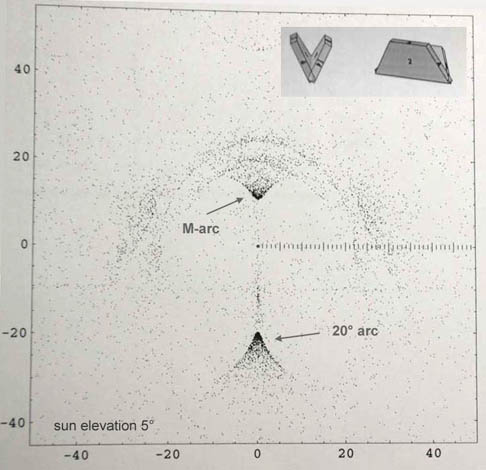Several of us have been talking about a possible explanation for M-arcs. The responsible crystals are twinned trapezoidal plates that have what might be called restricted Lowitz orientations. The crystals perform rotational oscillations about a horizontal axis, with the equilibrium orientation having the vee opening directly upward, as in the left hand crystal.
All of us are more or less skeptical about this explanation, but we think it deserves testing. The model predicts a strong lower 20° arc. We are asking that, if you are lucky enough to see an M-arc, then please put yourself in an elevated position and look for the lower 20° arc. There are other observing suggestions as well, but I think I will leave them for the blog.
(Walt Tape)

One shotcoming of this model may be that it produces an arc that stays all times at the same distance from the light source. Several photos indicate that Moilanen arc takes distance from light source the higher the light source gets. But measurable photos are rather scarce. We would need more of them and that's why sun or moon should be blocked with filter. Especially high light source (>20 degs) are of interest.
ReplyDeleteI would love to believe this hypothesis of the M-arc origin since we frequently see these kinds of crystals under microscope. The required 34 degree engle between faces is readily there. But:
ReplyDelete- the appearence of the V in the simulations does not quite match the photographs
- As Marko pointed out, we have a reasonable confidece about the movement of the halo as a function of light source elevation
- the crystals in our microscopes are a bit diferent: they are much thinner than the ones used in simulation above. This may not be a cruicial fact, however, since the light may very well find a way through a thin plate with successive basal face reflections and meet the other required face
As is said in the actual post: we need M-arc displays without tangent arcs. If there still exists a halo below the sun it would strenghten this theory remarkably. Once again, one should be able to measure the distance between light source and halo accurately (welding glass in front of sun and an additional star field photo taken with the same lens/camera)
For those who photograph crystals, any displays, also those that don't have Moilanen, are valuable. Especially samples from diamond dust where the Moila is first not present and then appears, should be interesting. This should allow us to at least narrow down the suspects, even if the very structure in the crystal that makes Moilanen arc decides to keep playing seek and hide.
ReplyDeleteI can tweak the simulation to try to modify the shape and position of the arc, but it seems like a waste of effort unless somebody sees a lower 20deg arc and an M-arc together. Until that happens, I cannot get too excited about this model.
ReplyDeleteYeah I agree with so many observations of this arc it really is bugging me because I myself have yet to see one. Its in the teens right now in Southern Ohio but I have no clay and my halo gun is in my barn which cannot be opened because we have three kittens living in it that are being kept warm. I hope one of you folks will solve the mystery behind M-arc and for any who does should get the nobel prize.
ReplyDeleteFolks, starting tomorrow, the forecast says, it's gonna be clear skies, low temps and calm conditions for at least four days here in Finland. Most of us are ready to go
ReplyDelete